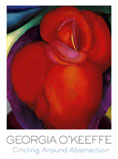
By the early 1920s, O'Keeffe had begun to tire of the way in which her art had come to be most often interpreted: as loosely veiled allusions to her gender and sexuality. In an effort to avoid such readings, she began to focus on more traditional subjects (such as landscapes and still lifes) and more objective ways to represent them. But this shift did not necessarily mean that O'Keeffe had given up experimenting with abstraction. In fact, her paintings from the early 1920s-particularly the series of still lifes featuring apples and avocados (called "alligator pears")-reveal not only her desire to have her art accepted on terms other than those tied to her gender, but also the depth of her understanding of (and willingness to engage with) some of the key elements of modern art.
The most notable influences on O'Keeffe's paintings of this period appear to have been the simplified forms, spatial compression, and delicately balanced compositions of Paul Cézanne's still lifes and the radically cropped, tightly focused photographs by Alfred Stieglitz's newest protégé, Paul Strand.

